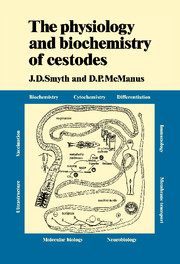Book contents
- Frontmatter
- Contents
- Preface
- Acknowledgements
- 1 The cestodes: general considerations
- 2 The adult cestode: special structural features relevant to its physiology
- 3 The adult cestode in its environment
- 4 The adult: general metabolism and chemical composition; lipid metabolism
- 5 The adult: carbohydrate metabolism
- 6 The adult: proteins and nucleic acids
- 7 The biology of the egg
- 8 Developmental biology of larvae
- 9 Development within definitive host
- 10 Cultivation of cestodes in vitro
- 11 Immunobiology of cestodes
- References
- Index
9 - Development within definitive host
Published online by Cambridge University Press: 24 November 2009
- Frontmatter
- Contents
- Preface
- Acknowledgements
- 1 The cestodes: general considerations
- 2 The adult cestode: special structural features relevant to its physiology
- 3 The adult cestode in its environment
- 4 The adult: general metabolism and chemical composition; lipid metabolism
- 5 The adult: carbohydrate metabolism
- 6 The adult: proteins and nucleic acids
- 7 The biology of the egg
- 8 Developmental biology of larvae
- 9 Development within definitive host
- 10 Cultivation of cestodes in vitro
- 11 Immunobiology of cestodes
- References
- Index
Summary
Mechanism of invasion
In spite of the vertebrate intestine being a biologically hostile environment for parasites, cestodes have been very successful in developing a wide range of morphological, physiological and biochemical adaptations which enable them to become established and to reproduce there.
With rare exceptions (e.g. Archigetes, H. nand), a host becomes infected by ingesting an intermediate host containing a cestode larva which may be (i) free, (ii) encysted, (iii) encapsulated, or (iv) both encysted and encapsulated. The term encysted is used when a cyst is produced by the parasite, encapsulatedwhen it is produced by the host. In the latter case, the cyst may sometimes (e.g. Echinococcus) consist of two layers, the outer of which is derived from the host and the inner from the larva. The larval scolex is normally invaginated or withdrawn - a measure which presumably protects the scolex until it is stimulated to evaginate in the appropriate region of the host gut. To become established in the gut, therefore, a larva must (a) free itself from its surrounding membranes (i.e. excyst), (b) evaginate its scolex, (c) become ‘activated’ and (d) become attached to the intestinal mucosa. Excystment and evagination General account ROLE OF ENZYMES Although excystment and evagination are theoretically separate processes, in many cases the second follows so closely after the first that they cannot readily be separated.
- Type
- Chapter
- Information
- The Physiology and Biochemistry of Cestodes , pp. 232 - 256Publisher: Cambridge University PressPrint publication year: 1989



